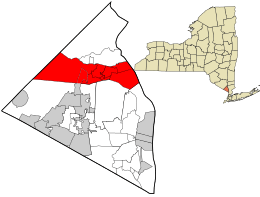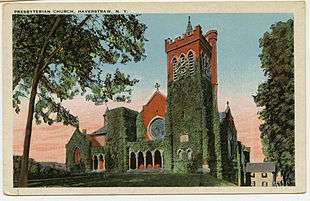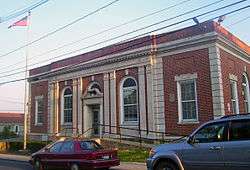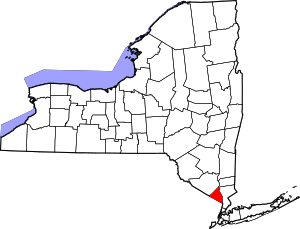Haverstraw, New York
Haverstraw /ˈhævərˌstrɔː/ is a town in Rockland County, New York, United States, located north of the Town of Clarkstown and the Town of Ramapo; east of Orange County, New York; south of the Town of Stony Point; and west of the Hudson River. The town runs from the west to the east border of the county in its northern part. The population was 36,634 at the 2010 census.[4] The name comes from the Dutch word Haverstroo meaning "oats straw",[5] referring to the grasslands along the river. The town contains three villages, one of which is also known as Haverstraw. Haverstraw village is the original seat of government for the town, hosting the area's historic central downtown business district and the densest population in northern Rockland County.
Haverstraw | |
|---|---|
Town | |
Skyline | |
 Location in Rockland County and the state of New York. | |
 Haverstraw Location of Haverstraw in New York | |
| Coordinates: 41°11′47″N 73°58′01″W | |
| Country | United States |
| State | New York |
| County | Rockland |
| Settled | 1616 |
| Established | 1788 |
| Government | |
| • Supervisor | Howard T. Phillips Jr. |
| • Town Council | Isidro Cancel, Vincent J. Gamboli, John J. Gould, and Hector L. Soto |
| Area | |
| • Total | 27.41 sq mi (71.00 km2) |
| • Land | 22.15 sq mi (57.38 km2) |
| • Water | 5.26 sq mi (13.63 km2) |
| Population | |
| • Total | 36,634 |
| • Estimate (2016)[3] | 37,414 |
| • Density | 1,688.81/sq mi (652.05/km2) |
| Time zone | UTC-5 (Eastern (EST)) |
| • Summer (DST) | UTC-4 (EDT) |
| FIPS code | 36-087-32765 |
| Website | www.townofhaverstraw.org |
History
In 1609, the region was explored by Henry Hudson. A land purchase was made in this town in 1666 from local natives and confirmed as a patent in 1671. The region was known as Haverstroo, meaning "oat straw" in Dutch.
During the American Revolution, it served as an important lookout for British activities on the Hudson. A blue-marked trail, the Long Path, may be taken 2 miles (3 km) eastward from Central Highway along the crest of South Mountain to High Tor. Halfway is Little Tor, the second highest peak on South Mountain.
The town of Haverstraw was formed in 1788 while still part of Orange County, New York. Haverstraw was partitioned in 1791 to form the town of Clarkstown and the town of Ramapo and again in 1865 to form the town of Stony Point.
In 1826 the town was the site of a short-lived effort to establish an Owenite colony called the Franklin Community.[6] Underfinanced and wracked by internal dissent, the model Owenite community folded after a mere five months of operation.[6]
Geography

According to the United States Census Bureau, the town has a total area of 27.4 square miles (71.0 km2), of which 22.2 square miles (57.4 km2) is land and 5.3 square miles (13.6 km2), or 19.19%, is water.[7]
Demographics
| Historical population | |||
|---|---|---|---|
| Census | Pop. | %± | |
| 1790 | 4,826 | — | |
| 1820 | 2,700 | — | |
| 1830 | 2,306 | −14.6% | |
| 1840 | 3,449 | 49.6% | |
| 1850 | 5,885 | 70.6% | |
| 1860 | 8,123 | 38.0% | |
| 1870 | 6,412 | −21.1% | |
| 1880 | 6,973 | 8.7% | |
| 1890 | 9,079 | 30.2% | |
| 1900 | 9,874 | 8.8% | |
| 1910 | 9,335 | −5.5% | |
| 1920 | 9,027 | −3.3% | |
| 1930 | 11,603 | 28.5% | |
| 1940 | 12,443 | 7.2% | |
| 1950 | 12,979 | 4.3% | |
| 1960 | 16,632 | 28.1% | |
| 1970 | 25,311 | 52.2% | |
| 1980 | 31,929 | 26.1% | |
| 1990 | 32,712 | 2.5% | |
| 2000 | 33,811 | 3.4% | |
| 2010 | 36,634 | 8.3% | |
| Est. 2016 | 37,414 | [3] | 2.1% |
| U.S. Decennial Census[8] | |||
As of the census[9] of 2000, there were 33,811 people, 11,255 households, and 8,328 families residing in the town. The population density was 1,508.3 people per square mile (582.3/km²). There were 11,553 housing units at an average density of 515.4 per square mile (199.0/km²). The racial makeup of the town was 66.24% White, 10.27% Black or African American, 0.41% Native American, 3.21% Asian, 0.10% Pacific Islander, 15.65% from other races, and 4.12% from two or more races. Hispanic or Latino of any race were 31.73% of the population.
There were 11,255 households out of which 37.3% had children under the age of 18 living with them, 54.4% were married couples living together, 15.0% had a female householder with no husband present, and 26.0% were non-families. 21.3% of all households were made up of individuals and 7.8% had someone living alone who was 65 years of age or older. The average household size was 2.94 and the average family size was 3.43.
In the town, the population was spread out with 26.3% under the age of 18, 8.6% from 18 to 24, 31.2% from 25 to 44, 23.6% from 45 to 64, and 10.3% who were 65 years of age or older. The median age was 35 years. For every 100 females, there were 93.7 males. For every 100 females age 18 and over, there were 89.4 males.
The median income for a household in the town was $53,850, and the median income for a family was $61,119. Males had a median income of $40,109 versus $31,979 for females. The per capita income for the town was $22,188. About 8.1% of families and 10.6% of the population were below the poverty line, including 12.8% of those under age 18 and 13.8% of those age 65 or over.
Government
Town board
The Town Supervisor is Howard T. Phillips Jr. The Town Councilmen are Vincent Gamboli, John J. Gould, Hector L. Soto and Isidro "Papo" Cancel.
Police department
The town of Haverstraw is protected and served by over eighty men and women. The Village of Haverstraw Police Department merged with the Town of Haverstraw Police Department in January 2006 and now serve as one department protecting both the town and the village. HTPD serves under the command of Chief Peter Murphy. This police department is a diverse force and consists of about 80 police officers with one part-time police officer.
The Town of Haverstraw Police Department is home to five officers who received New York State's highest award for bravery in the line of duty. The New York State Police Officer of the Year award for 2000 was granted to Lieutenant Martin Lund, Sergeant Wayne Dunn, Sergeant John P. Lawless, Detective Brian Lauler and Police Officer Gregg Gaynor for their heroic acts. These officers repeatedly entered a burning three-story 52-unit apartment building to alert and evacuate many of the still sleeping residents. All of the officers had to brave thick smoke, intense heat and flames. They worked their way through the building, at times crawling on the floor, to escort frightened and disoriented residents from the building. Many small children had to be carried. Two of the officers suffered smoke inhalation and a third was treated for a laceration to his leg, as well as smoke inhalation. Governor Pataki recognized each officer for their actions in an award ceremony held in the village of Haverstraw.
Transportation
Major highways include the Palisades Interstate Parkway, U.S. Route 9W, U.S. Route 202, and NY Route 45. Haverstraw is also a terminus of the NY Waterway/Metro North Haverstraw–Ossining Ferry.
New York Central's West Shore Railroad began operations along the banks of the Hudson in 1883 and operated passenger service between Albany and Weehawken Terminal in Weehawken, New Jersey, where passengers could transfer to ferries to Manhattan.[10] Service was discontinued in 1959. The right of way is still used for freight and is known as the River Line. Conrail operated the system until its dissolution. It is now part of the CSX River Subdivision which runs between North Bergen Yard in New Jersey and Selkirk, New York.
Communities and locations in the town
- Bowline Point Town Park – A park east of Haverstraw on a peninsula, called Bowline Point, in the Hudson River.
- Camp Hill – A hamlet near the south town line.
- Dutchtown – The southern most section of the Village of Haverstraw.
- Felters Corners – A hamlet west of Garnerville.
- Garnerville – A hamlet southwest of West Haverstraw.
- Harriman State Park – Part of the park is in the western part of the town.
- Village of Haverstraw – The historic downtown business district. The original seat of government in Haverstraw Town.
- Johnsontown – A hamlet west of West Haverstraw named after the Johnson brothers.
- Ladentown – A hamlet.
- Lake Kanawauke – A lake in Harriman State Park in the southwest corner of the town.
- Lake Sebago – A lake in Harriman State Park in the southwest corner of the town.
- Lake Welch – A lake in Harriman State Park near the west town line.
- Mount Ivy – A hamlet by the south town line.
- Pomona – A village partly in the town and partly in the town of Ramapo.
- Samsondale – A hamlet east of West Haverstraw.
- St. John's in the Wilderness – A hamlet.
- Thiells – A hamlet west of West Haverstraw.
- West Haverstraw – A village.
- Willow Grove – A hamlet on the north town line.
Education
The Roman Catholic Archdiocese of New York operates Catholic schools in Rockland County. St. Peter Parish School was in Haverstraw. In 2012, after the archdiocese announced that it could potentially be closed, the school community did a fundraising drive as the school was told it could remain open if a plan to raise $500,000 annually was produced. That year the school's per-student cost was $5,500 but it relied on archdiocese funds as it deliberately had tuition below cost, at $3,600,[11] so children of working class backgrounds could attend. It had an increasing enrollment at the time of closure, with 328 students in its final year.[12]
Historical figures who have visited Haverstraw

Aaron Burr, third Vice President of the United States, was a frequent visitor to this area. It is said that Aaron Burr studied law at the office of Thomas Smith, owner of the Belmont House (Treason House), which was occupied by his brother, Joshua Hett Smith – the location where Major André, accompanied by Benedict Arnold who commanded West Point, had agreed to surrender West Point to the British for £20,000 ($1.1M in 2008 dollars). Legend says that Aaron Burr carved his initials in the mantel at the Treason House. The Haverstraw Post Office now stands were the office once stood.
During the American Revolution, the Commander-in-Chief General George Washington and Comte de Rochambeau occupied the Treason House.
General Marie Joseph Paul Yves Rock Gilbert du Motier, better known as the Marquis de Lafayette, was a Revolutionary War hero and a leader of the Garde Nationale during the French Revolution. His camp was located on a hill in the western area of Haverstraw and the site has since been known as Camp Hill.
Henry Lee III (January 29, 1756 – March 25, 1818) was an early American patriot who served as the 9th Governor of Virginia and a member of the U.S. House of Representatives from Virginia's 19th district. During the American Revolution, Lee served as a cavalry officer in the Continental Army and earned the name Light-Horse Harry Lee. He engaged in battle with the British on land behind Lady Warren Fire House where the pond now is. He was also the father of Confederate general Robert E. Lee.
Haverstraw was known as a favorite hang out for baseball's immortal Babe Ruth during the 1920s and he even recorded a silent film there early in the decade.
Notable people
- Walter S. Gurnee, Fourteenth Mayor of Chicago
- Abram Stevens Hewitt (1822–1903) was a teacher, lawyer, iron manufacturer, U.S. Congressman, and a mayor of New York.
- Molly McGee (1952–1994), gridiron football player
- Michael H. Prendergast (1913–1990) – New York State Democratic Chairman, July 1955 – February 1962
- Marty Springstead, American League Umpire
- Scott Stanford (1977) – WWE Superstars play-by-play announcer working for the Raw brand
- Both the composer Kurt Weill and his wife, the actress and singer Lotte Lenya, are buried in Haverstraw
- Robert Sterling Yard, journalist, environmentalist
Haverstraw was home to three Medal of Honor recipients:
- Richard Smith, 95th New York regiment, Civil War
- Nick Erickson, Navy, Spanish–American War
- Michael A. Donaldson, 69th New York, World War I
Footnotes
- "2016 U.S. Gazetteer Files". United States Census Bureau. Retrieved July 5, 2017.
- "U.S. Census website". United States Census Bureau. Retrieved May 14, 2011.
- "Population and Housing Unit Estimates". Retrieved June 9, 2017.
- "Profile of General Population and Housing Characteristics: 2010 Demographic Profile Data (DP-1): Haverstraw town, Rockland County, New York". United States Census Bureau. Retrieved February 1, 2012.
- Gannett, Henry (1905). The Origin of Certain Place Names in the United States. Govt. Print. Off. pp. 152.
- Arthur Bestor, Backwoods Utopias: The Sectarian Origins and the Owenite Phase of Communitarian Socialism in America, 1663-1829. [1950] Enlarged 2nd Edition. Philadelphia: University of Pennsylvania Press, 1970; pp. 203-204.
- "Geographic Identifiers: 2010 Demographic Profile Data (G001): Haverstraw town, Rockland County, New York". United States Census Bureau. Retrieved February 1, 2012.
- "Census of Population and Housing". Census.gov. Retrieved June 4, 2015.
- "U.S. Census website". United States Census Bureau. Retrieved January 31, 2008.
- "Intercity passenger trains serving New York via New Jersey terminals in 1942, 1956, and 1971 immediately prior to the creation of Amtrak". New York's Passenger Trains of the Past. Retrieved February 13, 2012.
- "St. Peter's supporters in Haverstraw use Facebook, YouTube in bid to save school". Lower Hudson Journal News. December 22, 2012. Archived from the original on January 21, 2013. Retrieved May 5, 2020.
- Otterman, Sharon (January 15, 2013). "Catholic Schools Await More Closing Bells". The New York Times. Retrieved May 5, 2020.
Further reading
- George H. Budke, Rockland County during the American Revolution, 1776 – 1781. New York: Rockland County Public Librarians Association, 1976.
External links
| Wikimedia Commons has media related to Haverstraw, New York. |
| Wikisource has the text of the 1921 Collier's Encyclopedia article Haverstraw. |
